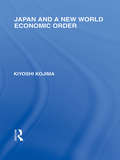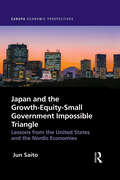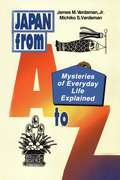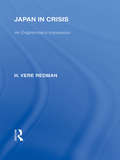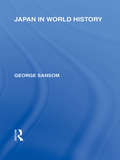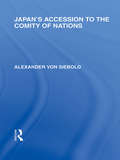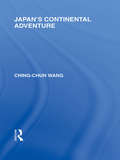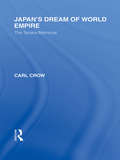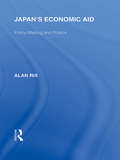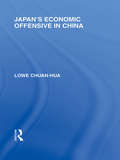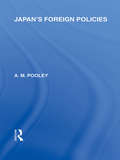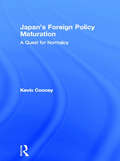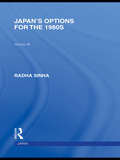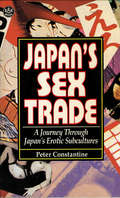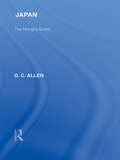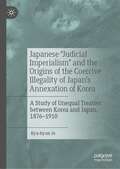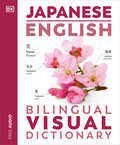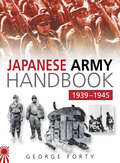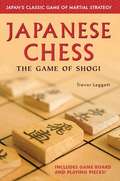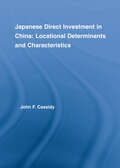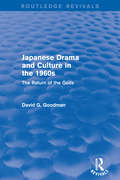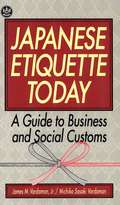- Table View
- List View
Japan and a New World Economic Order (Routledge Library Editions: Japan)
by Kyoshi KojimaPresident Nixon’s new economic policy of August 1971, aggravated by the oil problem since October 1973 caused chaos and uncertainty in the international trade and currency system. There were fears of another 1930s style depression. In addition, a world food shortage and strident claims by developing countries for perpetual sovereignty over resources added another set of difficulties. This volume, written from Japan’s standpoint, suggests a new direction for the world and regional economic order. The book tackles two major issues in international economics: Firstly, traditional international trade theory aims only at static maximization in the use of world human and material resources, but, the author stresses more attention should be paid to such dynamic or developmental elements as population growth, immigration, natural resource development, improvement in transfer of technology, economies of scale, direct foreign investment and economic integration in order to create development centres or sectors in the world economy. Secondly, the author discusses how to combine a global and regional approach to economic integration.
Japan and the Growth-Equity-Small Government Impossible Triangle: Lessons from the United States and the Nordic Economies (Europa Economic Perspectives)
by Jun SaitoThis volume examines and analyzes the current situation of, and the future prospects for, the Japanese economy, particularly in the context of inequality. The country's economy is facing the ageing and the shrinking of its population, both of which will reduce the potential growth rate, which has already become very low. By introducing a new policy framework, namely the `Equity-Growth-Small Government Impossible Triangle', based on reviewing, comparing and contrasting the policies of the United States, the Nordic economies and Japan, the book proposes a policy direction that could be pursued by Japan. If Japan wants to sustain growth while preventing inequality to widen and preserve an egalitarian society, there is no other choice but to further promote globalization and innovation and, at the same time, surrender preserving a small government by reforming itself to become a dynamic and resilient welfare state. The volume will be an invaluable resource for students, professionals and researchers with an interest in economics, inequality, the Japanese economy and comparative economic policies.
Japan from A to Z: Mysteries of Everyday Life Explained
by Michiko Sasaki Vardaman James M. VardamanThis Japanese travel guide provides goes beyond the typical guidebook, revealing the underlying cultural and historical reasons for the behavior and attitudes of The Japanese.<P><P>Authors Michiko and James Vardaman identify nearly three hundred aspects of Japanese culture, custom, and daily life that commonly frustrate, delight, or just plain stump non-Japanese. For each topic, they provide historical and other background that helps strip away some of the mystery surrounding Japanese culture, and make inscrutable Japan a little more scrutable. Drawings and illustrations help illustrate some objects that may be unfamiliar to Westerns, such as "New Year's rakes," Japanese water sprites, and wish tablets.Japan from A to Z fills in holes left by more academically oriented books on Japan by providing information on topics that readers would be unable to find in more staid, conventional sources. Fun and fascinating for tourist and resident alike, it offers a concise, readable introduction to the country and its way of life.
Japan in Crisis: An Englishman's Impression (Routledge Library Editions: Japan)
by Hugh Vere Redman"...The Japanese are not so black as they are painted or so immaculate as they occasionally paint themselves." As the author’s own words suggest, this book attempts to give a balanced account of Japan during the "crisis" years of 1931-1935 which were some of the most significant in modern Japanese history. They saw an act of political expansion unique in the years following World War One, as well as an expansion of Japanese foreign trade in markets hitherto dominated by the exports of other countries. The letters re-issued here were written for both the Western and Japanese reader and as such represent an unrivalled impartial resource.
Japan in World History (Routledge Library Editions: Japan)
by George SansomIn this volume the author considers what the purpose and method of advanced Japanese studies should be. He believes that the study of Japanese history should be, not an end in itself but an integral part of world history. He discusses areas of controversy in interpretation which arise when a comparative method is used and Japanese history is examined in correlation with world history.
Japan's Accession to the Comity of Nations (Routledge Library Editions: Japan)
by Alexander von SieboldThis volume is based upon personal observations and recollections of the author extending over six different periods of residence in Japan between 1859 and 1877. It examines how the focus of the West towards Japan changed, as Japan became a dominant force in the political arena of the Far East when it freed itself of Chinese rule and, through the Meiji restoration adopted a democratic system of government based on the West. This rapid development in the history & governance of a nation had never been seen before on such a scale and this volume therefore covers a momentous period in the history of the Japan and its role in international politics.
Japan's Continental Adventure (Routledge Library Editions: Japan)
by Ching-Chun WangThis book contains eighteen studies on various important phases of Japan’s invasion of China. The appendix contains the historical declaration by Chiang-Kai-shek setting forth clearly the reasons why China took up arms against Japanese aggression, and a lucid chapter by the veteran sinologist Owen Lattimore on what Korea pays for Japan’s rule. Ever since the invasion of Manchuria by Japan in September 1931 the writer called attention to the fact that, in view of the League commitments, aggression in the East, if not properly stopped according to the League Covenant, would encourage aggression to spread beyond the limits of Asia.
Japan's Dream of World Empire: The Tanaka Memorial (Routledge Library Editions: Japan)
by Carl CrowDescribed as the Japanese Mein Kampf, this small pamphlet outlines the history of Japan which by the late 1920s was, according to the author, becoming a dream for world domination. Although this did not come to fruition, the book nonetheless represents a fascinating insight into the national psyche and political and military planning of the Japanese in the first half of the twentieth century. It focuses particularly on the Japanese policy in Manchuria and Mongolia.
Japan's Economic Aid: Policy Making and Politics (Routledge Library Editions: Japan)
by Alan RixJapan’s arrival since World War Two as a major industrial nation has meant that she has had to bear a greater share of the developed world’s contribution to the developing nations and foreign aid has become an integral part of foreign policy. This book describes the roots of Japan’s aid policy and shows that this side of her international economic policy is based largely on domestic conditions, structures and forces. To understand the pattern of Japanese aid as it stands today, it is important to appreciate the complexities of the Japanese decision-making process. This book clearly explains the patterns of Japanese aid policy-making.
Japan's Economic Offensive in China (Routledge Library Editions: Japan)
by Lowe Chuan HuaThis volume exposes Japan’s motives and designs on the economic front, pointing out the dangers of her policy of ousting Western interests and influence from East Asia during the conflict with China in Manchuria. The author urges the American and British governments to reconsider their position and strategy towards Japan. This book represents a fascinating insight into the power struggle between Japan & China in the early twentieth century.
Japan's Foreign Aid Challenge (Routledge Library Editions: Japan)
by Alan RixWhen this volume was published in 1993 it was the first comprehensive analysis of the major policy issues confronting Japan’s massive foreign aid programme. It deals with the philosophy behind Japan’s aid, Japanese reactions to the severe criticisms of its programmes and the beginnings of meaningful administrative reform of the complex aid system. Alan Rix goes on to examine the widespread innovation in programmes and policies to make Japan’s aid more responsive and the impact of the Asian bias in Japan’s aid.
Japan's Foreign Policies (Routledge Library Editions: Japan)
by A M PooleyThis volume draws together material from The Japan Chronicle, The Japan Gazette and the China Treaty Port foreign papers, all of which are of great historical value. The Japan and China Treaty Port foreign papers frequently contain important articles translated from the vernacular press. These original articles were often written by leading politicians and statesmen – Count Mutsu, Count Hayashi, Tang-shao-Yi, Wu-ting-Fang and Liang-chi-Chao were all prolific contributors. Written with the prospect of World War II looming, the rapid changes in the Far East happened almost without the West realising. This volume makes available key documents and analyses Japanese foreign policy with a view to directing UK handling of a delicate diplomatic situation in the Far East.
Japan's Foreign Policy Maturation: A Quest for Normalcy (East Asia: History, Politics, Sociology and Culture)
by Kevin CooneyThe sudden end of the Cold War took the Japanese foreign policy community by surprise. The Yoshida Doctrine which served Japanese foreign policy so well during the Cold War is no longer a viable foreign policy option. This dissertation examines the restructuring of Japanese foreign policy since the end of the Cold War. Through a series of 56 interviews with Japanese foregin policy elites, the changes in Japanese foreign policy are put into the context of the foreign policy literature.
Japan's Options for the 1980s (Routledge Library Editions: Japan)
by Radha SinhaJapan’s economic success since the 1950s created a range of serious domestic and international problems which threaten the stability of the country. Within Japan at the start of the 1980s there was a strong mood on the right for remilitarization to give the nation the super-power status her economic performance justified. Outside Japan, there was increasing pressure from the West to make her conform to Western strategic interests. Against the background of these crucial issues the book analyzes the economic, political and military options open to Japan. Focussing on the interconnecting themes of foreign harassment and domestic economic disorder, the author points out many areas of similarity between Japan of the 1930s and Japan of the 1980s.
Japan's Political Warfare (Routledge Library Editions: Japan)
by Peter de MendelssohnAfter more than six years of active fighting in the Far East and over two years of open war between Japan and the Anglo-Saxon powers, Japanese political warfare was still a factor largely unknown in the Western world. Overshadowed by the much nearer and more closely felt exertions of the Nazi propaganda machine, it came to be regarded as too remote to have any noticeable bearing on the general course of the war. In the months leading up to Pearl Harbour, Tokyo Radio, the official Domei News Agency and the Japanese press jointly conducted an efficient war of nerves which, for all its alleged clumsiness effectively deceived many in Britain and the USA. The attack on Pearl Harbour showed how Tokyo’s political warfare achieved its object: the creation of a political smoke-screen. During the period of Japan’s conquests in 1942 following Pearl Harbour, and before that in China, Japan’s political warfare showed itself quite capable of producing useful results.The volume is divided into two parts: the first deals with machinery and methods and gives as full and detailed a survey of the various government organs directing and controlling political warfare, the structure of the Japanese press, the organisation of Japanese broadcasting, the functioning of censorship and the extent to which education, science, literature, the arts and the cinema are being employed for purposes of propaganda, both in the Japanese homeland and in the wider area of the conquered empire. The second part deals with the aims and policies of Japanese propaganda, and attempts to give an outline of the way in which the machinery is being operated. It includes an analysis of the main groups of standard slogans and catchphrases which recur everywhere in Japanese propaganda and a special chapter is devoted to the use made of religion for purposes of political warfare.
Japan's Sex Trade
by Peter ConstantineJapan's Sex Trade offers a probing, step by step tour of the country's astonishing professional sex scene: salacious soaplands, hedonistic health clubs, and startling S&M snackbars, as well as the colorful characters who populate them and the off-color language they use. Highlighted are menus of the sexual services offered in each particular area of the red-light"floating worlds" with all specialties unblushingly detailed.As the reader journeys from act to act and location to location, a panorama of the amazing eccentricity of the Japanese sex business emerges. Scandalous and controversial, this picture will fascinate the reader
Japan: The Hungry Guest
by G C AllenWritten after the outbreak of war between Japan and China but putting aside British sentiments of suspicion, dislike and a sense of competition, G C Allen bases his observations of Japanese social, political and economic life on his first-hand experience of living and working in the country for a number of years. He argues that the economic expansion of Japan was regarded as a greater threat to Britain because of Japan’s political aims and aggressive territorial expansion, but he is at pains to explain the Japanese domestic circumstances which gave rise to this situation. He also argues that the expansion of the British Empire has some parallels with Japanese expansion, without condoning Japanese methods. Overall the author emphasizes the extent to which judgments about the qualities of the Japanese people have been influenced by the political views of writers in Western countries.
Japanese "Judicial Imperialism" and the Origins of the Coercive Illegality of Japan's Annexation of Korea: A Study of Unequal Treaties between Korea and Japan, 1876–1910
by Kyu-hyun JoThis book explores the legacy of the Japanese empire in Korea, asking how colonialism arose as a legal idea. What was the legal process behind the establishment of colonialism as Japan's prime strategy towards Korea since the late 19th century? By addressing such questions, it is not only possible to address how Japanese colonialism in Korea was born, but also address how the process behind the making of colonialism as a judicial and legal project was illegal from its origination. As East Asia grapples with a new generation of power politics, these sober reflects lend an important historical context to the struggles of the present.
Japanese - English Bilingual Visual Dictionary (DK Bilingual Visual Dictionaries)
by DKWith more than 6,750 fully illustrated words and phrases in Japanese and English, along with a free bilingual audio app, DK's Japanese-English Bilingual Visual Dictionary is your essential companion to life in any Japanese-speaking country.You will learn all the words and phrases you need to buy food and clothes, talk about work and education, visit the doctor, go to the bank, use public transportation, and much more. Perfect for tourists, business travelers, and students, the dictionary is incredibly easy to follow, with thematically organized vocabulary so you can find closely related words on a particular topic. Words and phrases are illustrated with full-color photographs and artwork, helping to fix new vocabulary in your mind. A comprehensive, two-way index provides an instant reference point for new Japanese vocabulary.The supporting audio app enables you to hear all the words and phrases spoken out loud in Japanese. The app is easy to use and helps you learn, remember, and pronounce important vocabulary. The dictionary gives a pronunciation guide for every Japanese word, and you can use this alongside the app to perfect your pronunciation.
Japanese Army Handbook 1939-1945: 1939-1945
by George FortyThis is an insight into the most feared army of World War II. The Japanese Imperial Army grew from 1.5 million men in 1939 to 5.5 million men by the end of the war. Their highly successful campaigns in the Far East and the Pacific at the beginning of World War II were every bit as spectacular as those of the Germans in Europe, and they earned an enviable reputation as expert jungle fighters which it took some years for the Allies to match. Their code of honour also made them extremely cruel enemies to prisoners and civilians alike, while their Kamikaze suicidal tendencies meant they would automatically fight to the last without any thought of surrender. Fully illustrated with rare archive photographs, this is a comprehensive study of the army. The author describes how they mobilized and trained their soldiers, and looks at their organizational structures, from high command down to divisional level and below. Also included are uniforms, equipment, all kinds of weapons ranging from tanks and artillery, technical equipment, tactics, symbology and vehicle markings.
Japanese Chess
by Alan Baker Trevor LeggettThe ancient game of chess has its roots in India, where the legendary emperor Ravana used it to exercise his generals in strategy and tactics. Played by millions around the world, shogi is the uniquely Japanese variant of chess.Japanese Chess is the ultimate book on shogi for beginners and experienced players alike. Its step-by-step instructions and easy-to-follow diagrams lead the reader through the strategies and intricacies of one of Japan's most popular board games. Shogi is the only variation of chess in which an opponent's captured piece can be dropped back onto the board as one's own. This makes for extremely exciting, dynamic game play in which momentum can quickly shift back and forth between players.This essential resource includes a shogi board bound right into it, folding out for use with the included shogi pieces.
Japanese Chess
by Alan Baker Trevor LeggettThe ancient game of chess has its roots in India, where the legendary emperor Ravana used it to exercise his generals in strategy and tactics. Played by millions around the world, shogi is the uniquely Japanese variant of chess.Japanese Chess is the ultimate book on shogi for beginners and experienced players alike. Its step-by-step instructions and easy-to-follow diagrams lead the reader through the strategies and intricacies of one of Japan's most popular board games. Shogi is the only variation of chess in which an opponent's captured piece can be dropped back onto the board as one's own. This makes for extremely exciting, dynamic game play in which momentum can quickly shift back and forth between players.This essential resource includes a shogi board bound right into it, folding out for use with the included shogi pieces.
Japanese Direct Investment in China: Locational Determinants and Characteristics
by John F. CassidyChina, with the world's largest population, is set to become the second largest market in the world by 2010. The importance of understanding the environment for foreign direct investment (FDI) in China has never been more apparent. With this as a context, this book examines FDI in China with the emphasis on the 'where to locate' question. Japanese direct investment is used as a case study elucidating the key locational determinants and characteristics thereof. This is the first book focusing on the 'where to locate' question with respect to the China market. All companies with a China strategy and all university business departments will find this book of vital importance.
Japanese Drama and Culture in the 1960s: The Return of the Gods (Routledge Revivals)
by D.G. GoodmanThis title was first published in 1988: In this book the author has translated five postwar experimental Japanese plays and recreated the artistic, social and spiritual milieu in which they were created. He describes the turning point in Japanese thinking about the nature and limitations of a Western-oriented modern culture, and the creation of "underground" theatres which in which evolved a new mythology of history. Professor Goodman sees these developments as an interplay between personal and political (ie revolutionary) salvation.
Japanese Etiquette Today
by Michiko Sasaki Vardaman James M. VardamanJapan today "looks" more and more Western, principles governing social and business relations become harder to see. Most foreigners know that Japanese etiquette differs from that of other countries, but few people know the extent of the differences. It is this diversity that first attracted the authors of Japanese Etiquette Today, a book written to make working and living in Japan enjoyable and rewarding experiences.The authors look at a variety of formal and informal occasions governed by subtle rules-visiting a Japanese office and h ome, giving and returning gifts, attending weddings and funerals, and much more. The result is an informal overview of Japanese society and a manual of practical advice on getting a long in that society. Complete with essential vocabulary and phrases, this handy guidebook explains what to do and perhaps more important what not to do, what to say, what to wear, indeed, whatever you need to observe the complex rules of modern Japanese etiquette.
